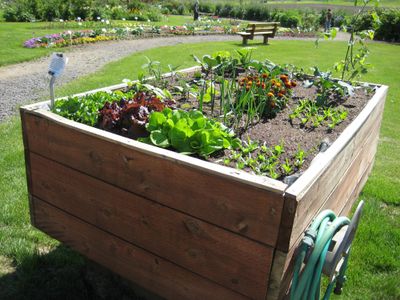Fairbanks garden offers valuable lessons

In keeping with my Alaskan theme for today’s garden columns, I wanted to share some information about a wonderful garden on the campus of the University of Alaska Fairbanks. The Georgeson Botanical Garden was established in 1989, and while it has many types of demonstration beds, the vegetable garden captured my attention the most during a recent visit.
As you can imagine, gardening can be a challenge that far north, so I felt they could teach us a thing or two about short growing seasons. Let’s look at some weather statistics.
The Fairbanks area has about a 93-day growing season. Spokane’s is about 120. Gardeners plant their cool-season crops around May 25 and their warm-season crops around the first of June. They get an average of .79 inches of precipitation during April and May. Springtime temperatures range from 21 to 48 degrees F. In the summer, temperatures range from 56 to 61 degrees and they get about 6.5 inches of precipitation in June, July and August.
During September and October, temperatures range between 24 and 45 degrees and they only get about .22 inches of rain. Permanent snowfall begins the first or second week of October, while the first frost occurs between Aug. 27 and Sept. 18. In the winter – which the locals say lasts from November through March – they get about 53 inches of snow and temperatures range from minus 2 to 15 degrees F.
What’s quite notable is the amount of daylight hours they have. At summer solstice, Fairbanks averages about 22 hours of daylight. It dwindles to about 4 hours at winter solstice. That’s the glaring difference between gardening in Alaska and Spokane.
At the botanical garden, they have a demonstration garden with raised beds made from composite wood and covered with green plastic mulch, which increases the soil temperature, and, thus, plant production. I learned that Alaskans have been gardening with raised beds since the early 1900s as a way to increase production in their shorter, cooler season.
The garden also has a taller, accessible raised bed that allows gardeners who are unable to bend down to garden while standing. The lower portion of the bed is recessed to make room for their feet. In the bed, they use square-foot gardening techniques to plant small blocks of several vegetable crops.
A great deal of research is conducted at the botanical garden. For example, you might think that the lengthy summer daylight hours would be ideal for growing vegetables like winter squash. Not so. Their research has shown that squash plants, which require both male and female flowers to produce, are affected by the short periods of darkness. Plants were able to produce male flowers under these conditions, but not female flowers until the hours of darkness started to increase. Last year, while the young squash plants were still in the greenhouse, researchers increased the production of female flowers by moving them to a darkened room for 16 hours, followed by eight hours of sunlight. They significantly increased their squash production using this method, and are trying it again this year.
If you would like to learn more about this garden, go to www.uaf.edu/salrm/gbg/.